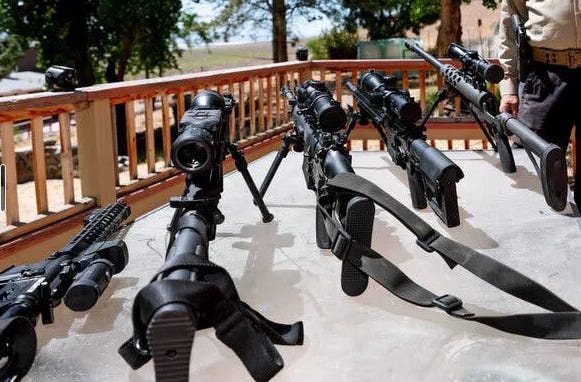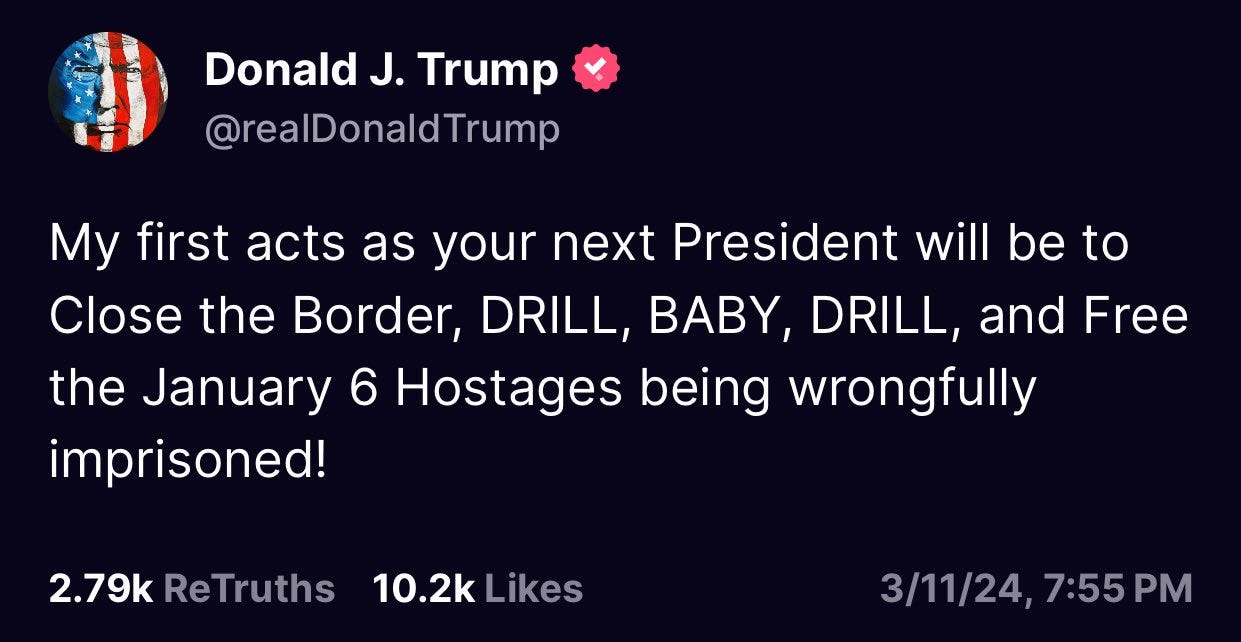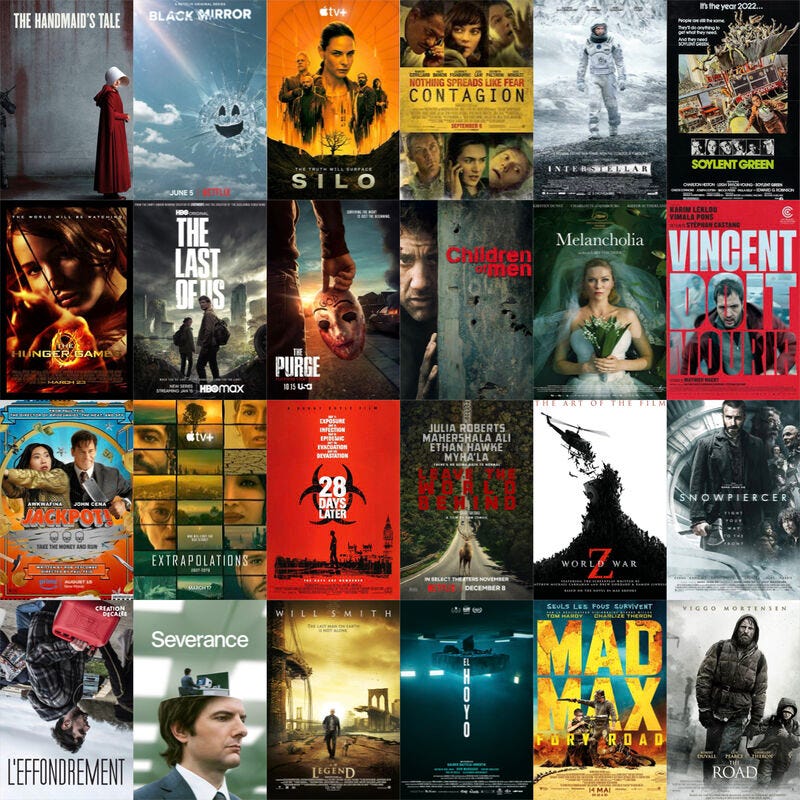Menu of this edition⌛ VERTIGO OF THE WEEK - Prepping or paranoia? Readiness in 2024
💚 EMOHACKS - Rifles or neighbors? Resilience beyond fear
⚖️ COACHING STORIES - Let go
🗞️ BREAKING NEWS - Update on AI, emotions & a fun video
⌛VERTIGO OF THE WEEK
You can’t escape it.
In a few weeks Angel Studios, (the studio behind phenomenons Sound of Freedom & The chosen) release an inspirational survivalist thriller called Homestead. The pitch: A nuclear bomb is detonated in LA, and the nation devolves into unprecedented chaos. A family moves into an eccentric prepper's fortress in the mountains.
Same old, same old?
The marketing campaign is new.
Giveaway prizes: Freeze Dried 6-Month Food Supply. Four Person Tactical Laser Airsoft Kit. 250-Gallon QuakeTank Water Storage Tanks. Portable Solar Power Unit. Fire starting kit.
You get the idea.
If hollywood goes there… Is survivalism the new sexy?
Should I go hide?
In Sweden, five million government brochures have landed in mailboxes last month, urging citizens to prepare for crises: war, cyberattacks, extreme weather. This year’s guide is twice as detailed as in 2018 and insists on private citizen preparation.
Extreme?
Finland government offers their own unique advice on "incident and crisis preparedness"since last week.

Extreme?
The Niinisto report on enhancing Europe’s civilian and defense preparedness and readiness, issued earlier this month, promotes a target of 72-hour self-sufficiency for each citizen. Experts increasingly advocate for two weeks of self-sufficiency.
Extreme?
The prepared.com, reference website on e-prep and prepping checklists, actually increases that 3 day window:
“Most modern experts believe you should be prepared for at least two weeks in order to handle the majority of likely events.” John Ramey (founder of theprepared)
💡 The question is clear: in an era of uncertainty, is preparedness still optional or has it become essential?Doomsday prepping: a business for lunatics?
Heard about the show “Doomsday Preppers”? Ramey explains:
When that program premiered on the National Geographic network in 2012, many reviewers dismissed it as comic relief. In the dozen years since, however, growing evidence of climate change, deepening political divisions and anxiety about artificial intelligence have made those apocalyptic fantasies somewhat less fantastical.
Almost 20 million Americans, or about 7 percent of all households, now identify as “preppers”, based on a recent analysis of FEMA data. More than half of Americans had taken three or more steps to prepare for disaster.
That’s HUGE.
“The market for preparedness will continue to grow as the world continues on the wrong trajectory.”
💡 Are we only talking about businesses aiming to seize on Americans’ deepening anxieties about the future? Or is there something more?What’s the offer? What’s the alternative?
Doomsday bunker for the superrich: we’ve all heard the stories.

Beyond that, a new phenomenon is growing: an “affordable survivable option for the middle class.” It illustrates an increased trend for individual protection/ willigness to prepare at different levels of society.
Take the Fortitude Ranch: pay $2,000 to $20,000 to join, and another $1,000 per year per person in dues to call this their “home fort,” meaning they will head there when catastrophe strikes. “800 members of Fortitude Ranch can use any of its five compounds in different statesfor recreational purposes for up to two weeks per year, a model similar to that of timeshares.” explains Drew Miller, founder: a business model for the apocalypse.
“Prepare for the Worst, Enjoy the Present,” is the Fortitude Ranch motto.
💚 EMOHACKS
What can you do about it?
What does it say about us?
We don’t want change.
We’ve gotten used to the idea that progress is inevitable.
GDP the ultimate KPI. Growth its compass.
The very idea of an alternate narrative is unthinkable.
It brings only fear.
Hence these dystopian ideas and prepping solutions become the only response.
The reason Trump celebrates saying “drill baby drill” is to pretend the current reality can continue as is. To extend the carbon pulse indefinitely. To sustain our way of life.
Are there other possible narratives?
When it comes to prepping, some prefer talking about “nature autonomy” or “risk management in natural environments” rather than talking about “survival.” French survival and self-protection instructor David Manise talks about how important it is to “reappropriate skills and knowledge. Rewild yourself a little.”
Beyond that, let’s not forget: the ultimate resilience comes from the community.
Choose your prepping: it’s ok to have a personnal survival bag ready and still build with others.
It’s way easier to close a door than bond with neighbours, but when the time comes we’ll need more than 3 weeks supplies.
💡 What will you choose: rifles or neighbours?Art & humor to build new narratives
Between 2010 and 2024, the number of dystopian films doubled, while the total number of movies grew by 82%.
I discovered Slovenian philosopher Slavoj Žižek through Timothee Parique’s post on our lack of imagination. Today’s cinema perfectly reflects his adage:
“It is easier to imagine the end of the world than the end of capitalism”.
Parrique ads: “Before anything can happen in reality, it has to happen in our heads. If we dare not even dream of post-capitalist futures, we are doomed to die suffocating in the present.”
To finish… a bit of wisdom. Read these lyrics from “Hope For The Best (Expect The Worst)” (theme song from the twelve chair’s 1970 mel brooks comedy):
I knew a man who saved a fortune that was splendid
Then he died the day he planned to go and spend it
Shouting "Live while you're alive! No one will survive!"
Life is sorrow—here today and gone tomorrow
Some would say: Always look on the bright side of life
💡 And that raises an important question: can you look at the bright side of life, and look up, at the same time?⚖️COACHING STORIES
As a coach,I work on beliefs and our attachment to our beliefs.
The concept of “saboteur” is a great example. We learn to expose them. Where they come from. How to live with them. And sometimes….
Let them go.
Yesterday my brother shared with me a tool he uses in short therapy.
Take something in your hand now. Like your bottle of water, a book, a tissue, a pen, whatever.
Raise your arm.
Now let it go.
It falls to the floor, right?
Now, question: What required an effort?
Holding it, or letting it go?
🗞️BREAKING NEWS
This Vertigo edition on prepping remind me of this article I wrote earlier this year on how to prepare emotionnaly: I talk about “turning on the flashlight 🔦: build your emotional emergency preparedness kit.”
Since Vertigo edition #11, Dario Amodei, CEO of anthropic, wrote a fascinating essay about superintelligence, expecting advanced AI as soon as 2027. I will get back to it soon, unless you want to listen to the 5h lex friedman podcast with Dario :)
Last, watch this Yes Men ad for the "SurvivaBall", an incredible mechanism to protect the rich from climate disasters:
I create quality spaces where you are listened to & get clarity.
Take this 8 question test & get a free personnalized feedback.
Even better, why don’t we have a chat? I'll ask you a question.
Maybe I'll share a tip, a read, an article.Maybe you'll want to know more, to get equipped, to finally face that issue stuck in your mind for a while.
Write me directly at mathieudufourpro@gmail.com
I answer all messages.









